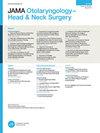Oncologic outcomes of microscopic tumor cut-through in locally advanced oral squamous cell carcinoma
引用次数: 0
Abstract
Introduction: The gold standard treatment of oral cavity squamous cell carcinoma (OCSCC) is surgical resection; however, standardization of the margins and the role of frozen section are still debatable. Microscopic tumor cut-thought (MTCT) occurs when the surgeon has an initial positive frozen section margin that is cleared with further resection to negative. Objective: This study aims to determine the impact of MTCT on local recurrence and disease-specific survival in patients with locally advanced T3-T4 OCSCC and compare it with other clinicopathological variables. Methods: A retrospective database analysis of patients diagnosed with locally advanced T3-T4 OCSCC surgically treated and submitted to intraoperative frozen section guiding the margin status. Survival was analyzed using the Kaplan-Meier estimator followed by the Cox model for multivariate analysis. Results: We analyzed 475 patients who met inclusion criteria: MTCT occurred in 29 patients (6.11%) and local recurrence was observed in 131 patients (27.6%). MTCT had an impact on univariate (HR 2.205; 95% CI 1.243 – 3.914; p =0.007) and multivariate (HR 1.851; 95% CI 1.285 – 2.666; p =0.001) analyses. Similar results were found for disease-specific survival: univariate (HZ 1.669; 95% CI 1.056 – 2.635; p =0.028) and multivariate (HZ 1.307; 95% CI 0.816 – 2.092; p =0.265) analyses. A total of 231 patients (48.6%) had died of cancer by the end of follow-up. The best predictor for compromised frozen sections was tumor depth of invasion. Conclusion: Even after negative final margins, MTCT is an important factor associated with poorer outcome, and treatment intensification should be considered in these patients.局部晚期口腔鳞状细胞癌显微肿瘤切开的肿瘤学结果
口腔鳞状细胞癌(OCSCC)的金标准治疗是手术切除;然而,边缘的标准化和冷冻切片的作用仍有争议。显微肿瘤切割(MTCT)发生在外科医生有一个最初的阳性冷冻切片边缘,通过进一步切除清除到阴性。目的:本研究旨在确定MTCT对局部晚期T3-T4 OCSCC患者局部复发和疾病特异性生存的影响,并与其他临床病理指标进行比较。方法:回顾性分析经手术诊断为局部晚期T3-T4 OCSCC的患者,并进行术中冷冻切片指导切缘状态。生存率分析采用Kaplan-Meier估计,Cox模型进行多变量分析。结果:我们分析了475例符合纳入标准的患者,其中29例(6.11%)发生MTCT, 131例(27.6%)局部复发。MTCT对单因素有影响(HR 2.205;95% ci 1.243 - 3.914;p =0.007)和多因素(HR 1.851;95% ci 1.285 - 2.666;P =0.001)分析。在疾病特异性生存率方面也发现了类似的结果:单变量(HZ为1.669;95% ci 1.056 - 2.635;p =0.028)和多因素(HZ 1.307;95% ci 0.816 - 2.092;P =0.265)分析。随访结束时,共有231例患者(48.6%)死于癌症。冰冻切片受损的最佳预测指标是肿瘤浸润深度。结论:即使最终切缘阴性,MTCT仍是预后较差的重要因素,应考虑加强治疗。
本文章由计算机程序翻译,如有差异,请以英文原文为准。
求助全文
约1分钟内获得全文
求助全文

 求助内容:
求助内容: 应助结果提醒方式:
应助结果提醒方式:


